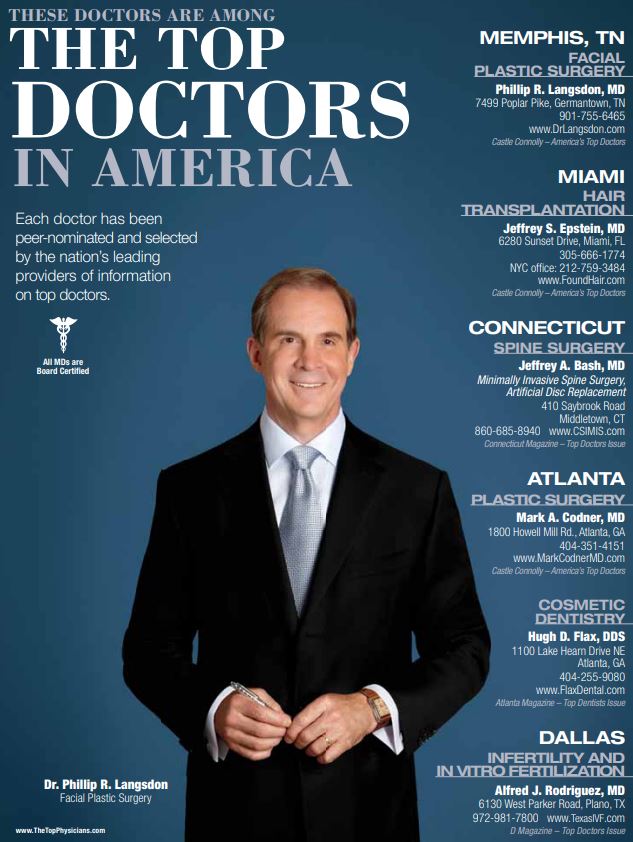Preservation Rhinoplasty in Memphis, TN, with Dr. Langsdon

Preservation rhinoplasty is an approach to nose-reshaping surgery (rhinoplasty) that preserves as much of the original tissue in the nose as possible to create natural-looking changes. In addition to producing beautiful results, preservation rhinoplasty reduces the risk of requiring a second procedure (revision rhinoplasty) to correct problems caused by an overly aggressive initial rhinoplasty. By taking a conservative approach and preserving as much structural tissue in the nose as possible, the chances of significant and unwanted changes to the nose over time are minimized.
While the concept of preservation rhinoplasty is relatively new, many of the techniques used in the approach are well-established. Some were in use before more aggressive techniques were introduced, but they have been refined and improved with advances in cosmetic surgery and increasing knowledge of nasal anatomy. The advanced refinements of these techniques make today’s preservation rhinoplasty such a successful procedure and account for its growing popularity.
Dr. Phillip Langdon is a leading figure in the field of facial plastic surgery. He has developed improved techniques for rhinoplasty, including a preservation rhinoplasty technique that enhances the natural look when changes are made to the tip of the nose. Dr. Langsdon served as president of the American Academy of Facial Plastic and Reconstructive Surgery (AAFPRS) in 2018-19 and is considered by many to be one of the best rhinoplasty surgeons in America.
To learn more about how preservation rhinoplasty in Memphis might benefit you, contact The Langsdon Clinic today to schedule a consultation with Dr. Langsdon.
How Is Preservation Rhinoplasty Different from Traditional or Structural Rhinoplasty?
One of the main differences between revision rhinoplasty and traditional or structural rhinoplasty is the way the nose bridge is altered. In the traditional approach, the bone and cartilage of the nose bridge are removed from the top. This changes the supporting structure of the nose in significant ways and can require reinforcement in the form of cartilage grafts. In preservation rhinoplasty, the nose bridge is altered by removing a small amount of bone and cartilage from below. Both approaches can reduce a hump in the nose. But in preservation rhinoplasty, more of the nose’s original structure is retained, and the results can look more natural.
Preservation rhinoplasty also lifts the skin during the procedure in a plane that has fewer blood vessels (the subperichondrial-subperiosteal plane). This is less disruptive to the tissue of the nose and results in minor swelling during recovery and less risk of extended numbness and excessive scarring.
Finally, preservation rhinoplasty maintains the cartilage in the tip of the nose while making the desired shape changes, rather than altering the cartilage with grafts, sutures, or other modifications. This reduces the risk of changes in the shape of the nose tip over time.
Why Might I Consider Preservation Rhinoplasty?
For certain changes in nose shape, preservation rhinoplasty offers a less invasive alternative to traditional rhinoplasty. The approach can:
- produce more natural-looking results
- reduce the risk of unwanted changes to the shape of the nose over time
- reduce the risk of breathing problems from a narrowed nasal airway
- result in a faster recovery with less short-term swelling and bruising
Preservation rhinoplasty can improve your facial appearance by:
- reducing a hump in the bridge of the nose
- narrowing a wide nose
- changing the shape of the tip of the nose
Some changes to the nose can’t be made with preservation rhinoplasty and require traditional rhinoplasty. These include:
- adding volume to the nose, as might be done to correct a “saddle nose”
- certain realignments of the nose to improve facial symmetry
- correcting complex nasal deformities
- correcting problems from an earlier structural rhinoplasty
Why Choose Dr. Langsdon as My Memphis Rhinoplasty Surgeon?
Dr. Langsdon is a pioneer in rhinoplasty surgery and is among the best rhinoplasty surgeons in America. Through his work with the American Academy of Facial Plastic and Reconstructive Surgery, which he led as president in 2018-18, he has organized and overseen the organization’s medical education program. He has published his innovations in surgical technique, taught young doctors specializing in facial plastic surgery, and led special rhinoplasty training programs for experienced plastic surgeons. He is among the select group of facial plastic surgeons who are skilled in performing preservation rhinoplasty procedures.
Dr. Langsdon’s expertise and innovations are all focused on one overriding goal: to produce beautifully natural-looking results for his patients. You should trust nothing less than a talented and compassionate surgeon for your rhinoplasty, and Dr. Langsdon has the experience and specialization to create outstanding results.

What Can I Expect in My Preservation Rhinoplasty Procedure?
Your rhinoplasty will be performed in The Langsdon Clinic’s ambulatory surgical center. In preparation for surgery, you will be given medication to help you relax, promote healing, and minimize post-operative swelling and bruising. For most patients, twilight sedation is use and supplemented by local anesthesia.
Preservation rhinoplasty, like all rhinoplasty, is a highly individualized procedure. The exact approach that Dr. Langsdon uses for your surgery will depend on your anatomy and your goals, as determined in your consultation.
Preservation rhinoplasty can be performed as an open or closed procedure. In an open procedure, a small incision is made just below the tip of the nose, between the nostrils. In a closed procedure, incisions are made inside the nose. What distinguishes preservation rhinoplasty from traditional rhinoplasty is that the incision follows a particular plane within the nose that has fewer blood vessels. This causes less disruption to the tissues of the nose and results in a faster recovery with less swelling.
If your rhinoplasty is being performed to correct a hump on your nose, Dr. Langsdon will remove small pieces of cartilage or bone from below the dorsal hump and from the septum (the tissue that separates the nostrils), which allows the ridge of the nose to settle into a lower and straighter line.
If you are having rhinoplasty to reshape the tip of your nose, Dr. Langsdon will make those changes by reshaping, but not removing, the cartilage in that part of the nose.
Once you are alert again after your sedation and anesthesia, a trusted friend or family member can drive you home.
Request a Consultation
If you have any questions or wish to schedule a personalized consultation with Dr. Langsdon, please contact our office.
What Can I Expect in Recovery After Preservation Rhinoplasty?
We will provide you with a post-operative recovery plan customized to the unique aspects of your rhinoplasty procedure. You can expect some swelling, bruising, and soreness at first, but Dr. Langsdon will prescribe pain medication to help with any short-term discomfort. To promote healing and minimize swelling, you will need to keep your head elevated for the first couple of days of your recovery.
You will need to rest at home for the first week after surgery and avoid strenuous activity for the first two weeks. Most patients are able to go back to office work or school a week after their rhinoplasty. Swelling will not be noticeable after a week or two, and the improvements to your nose will be visible then. Your results will continue to improve over the next few months, and it can take up to a year for residual swelling to completely disappear.
What Are the Risks of Preservation Rhinoplasty?
The risks of preservation rhinoplasty include those that are common to all forms of plastic surgery, including the risks from anesthesia and the risks of infection or excessive bleeding. Preservation rhinoplasty also comes with the risk that the nasal hump may come back. In an estimated 10 to 15 percent of cases, the nasal hump returns within the first few months after surgery.
Schedule Your Memphis Preservation Rhinoplasty Consultation Today
Contact The Langsdon Clinic today to schedule a consultation with Dr. Langsdon. During this consultation, Dr. Langsdon will:
- examine your nose, carefully analyzing the shape of your nasal structures and the quality of your skin
- consider the harmony of your facial features
- ask questions to understand your goals for the procedure
- give you his expert recommendation on the best approach to meet your needs
Patients seeking preservation rhinoplasty in Memphis have chosen Dr. Langsdon time and time again because of his natural and balanced results. When searching for the best rhinoplasty surgeon in America, Dr. Langsdon should be at the top of your list. We invite you to call 901-755-6465 or reach us online today.
Meet Dr. Langsdon
President of the American Academy of Facial Plastic and Reconstructive Surgery, 2018
Phillip R. Langsdon, M.D. is Clinical Professor, Department of Otolaryngology-Head & Neck Surgery, University of Tennessee Health Science Center, Memphis. Dr. Langsdon’s career has been limited and focused entirely on Facial Plastic Surgery and he has dedicated himself to the pursuit of excellence in his field.
Memphis, TN Preservation Rhinoplasty FAQs
The answer to this question depends on your goals for surgery. With preservation rhinoplasty, Dr. Langsdon will maintain and reshape your existing nasal structures instead of removing and reconstructing them. This approach reduces trauma, minimizes swelling, and leads to a more natural-looking result with faster recovery.
While many patients benefit from this technique, it’s best for people seeking small refinements to their nose instead of sweeping changes. Consult with Dr. Langsdon to determine your candidacy for this procedure.
Since preservation rhinoplasty is a less invasive and aggressive approach, patients typically don’t experience as much bruising and swelling compared to traditional rhinoplasty. Many of Dr. Langsdon’s patients look and feel good enough to return to work within a week.
Absolutely—though it’s crucial to have realistic expectations. Dr. Langsdon will take a conservative approach to refining your nose’s shape and size for an elegant, balanced outcome.
Most patients notice an initial improvement, somewhat obscured by swelling. However, because preservation rhinoplasty is gentler on your nasal framework, the early swelling and bruising should fade within the first two weeks, revealing your full results.
Yes! If you have functional concerns like an obstructed airway or a deviated septum, Dr. Langsdon can improve your ability to breathe through your nose while maintaining the integrity of your nasal anatomy.
In some cases, Dr. Langsdon can apply preservation principles to revision procedures, especially when correcting over-reduction from previous surgeries. However, the approach varies based on your case.
Dr. Langsdon will provide specific pre-op guidelines, but in general, staying hydrated, avoiding blood-thinning medications, and minimizing stress can optimize healing and help you achieve good outcomes.
Since preservation rhinoplasty is so technical, you must partner with an expert who has your best interests in mind. As a pioneer in preservation techniques, Dr. Langsdon has devoted his entire practice to the art and science of facial plastic surgery. He is a past president of the American Academy of Facial Plastic and Reconstructive Surgery—a testament to his talent and leadership ability. Throughout his career, he has shaped medical education, trained specialists, and advanced surgical innovation. Skill and compassion are paramount, and Dr. Langsdon uses both to create stunning results.
